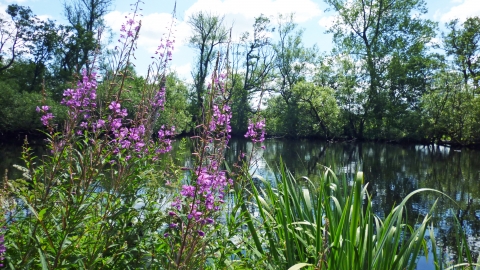
Black Firs & Cranberry Bog
Know before you go
Dogs
When to visit
Opening times
Open at all timesBest time to visit
Limited accessAbout the reserve
Highlights
- Black Firs was drained in the 1800's. See if you can spot the unusual concentric ring pattern of drainage ditches.
- Visit in summer and see if you can see one of our most uncommon and largest ferns, Royal Fern – frequently planted in gardens - seen here in its natural environment.
Created by glaciers
Designated as a Site of Special Scientific Interest and a Ramsar site, Black Firs & Cranberry Bog is one of a series of nationally important peatland sites that have developed in natural depressions, caused by ice-sheets which covered parts of Cheshire, Shropshire and Staffordshire some 15,000 years ago. Cranberry Bog is an outstanding example of a Schwingmoor basin mire. A ‘lawn’ of Sphagnum moss formed over a kettle-hole lake which was created by the glaciers. About 7,000 years ago Black Firs was probably a shallower lake, some 2m deep. Over time the open water would have gradually become vegetated with tall herbs
Drained by man
Maps from the 1800’s show the complex pattern of ditches which were dug around Black Firs so that the site could be drained and planted with trees. Although there are some mature trees from the original planting the woodland has become more ‘natural’ in recent years with species such as alder, oak, birch and sycamore. Some indication of the former fen vegetation can be seen along some of the wetter ditches which retain water for much of the year. These wetter areas support plants like yellow irises, Royal fern and the rare fine-leaved water dropwort. Water violets have been recorded in the past
A well kept secret!
Cranberry Bog has been less affected by historic management. The sphagnum lawn still exists and a small area of open water, Black Mere, is the remnant of the former kettle-hole lake. The lawn itself supports the characteristic plant which gives this part of the site its name – Cranberry. Other very rare plants include the insectivorous sundew, bog asphodel and white beak sedge.
Quality versus quantity?
Black Firs and Cranberry Bog is one of the Trust’s most complicated and least well understood wetlands. Over many generations man has developed great skills and expertise in draining wetland sites so that ‘waste’ land can be put to productive use. Successful historical drainage at Black Firs and Cranberry Bog threatens the diversity of plants and animals, and the ability to return the site to its former glory is less well understood. Black Firs continues to dry out and the remaining wetland plants are in decline. A deep ditch around the edge of the reserve drains water from adjoining land and takes run-off from roads and septic tanks and the water quality may potentially adversely affect the reserve. The hydrological link between Black Firs and Cranberry Bog is unclear. If we raise water levels at Black Firs will we end up flooding Cranberry Bog with poor quality water? The Trust is working closely with Natural England to monitor the site and develop plans for its long-term protection
One mans plant is another mans weed!
Visit Black Firs in summer and you can’t fail to notice the Himalayan Balsam that grows along the ditches. Himalayan Balsam is an annual plant which was introduced to the UK in 1839 and is now naturalised, especially on riverbanks. Each plant can produce up to 2,500 seeds and it is spreading prolifically across the countryside. Because it can tolerate low light levels it can out compete other plants and tends to shade out other vegetation. Himalayan Balsam was planted on land around the reserve in the 1970’s to provide a nectar source for honey bees. It is now an annual management task for volunteers to hand pull the plant to try and prevent it spreading onto the more sensitive parts of the reserve
Do your bit to help!
More than 94% of the UK's lowland bogs have been destroyed or damaged through peat extraction for use in gardens. Help conserve this unique and fragile habitat by asking for peat-free compost at your local garden centre
A Living Landscape
'Living Landscapes' is The Wildlife Trusts innovative approach to nature conservation and involves focusing our efforts on improving the wider landscape to make it better for wildlife. Find out more here


